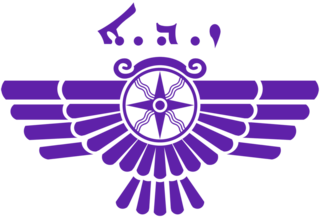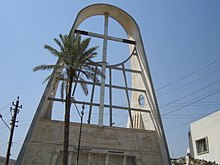The persecution of Christians from 1989 to the present is part of a global pattern of religious persecution. In this era, the persecution of Christians is taking place in Africa, the Americas, Europe, Asia and the Middle East.

The Assyrian Democratic Movement, popularly known as Zowaa, is an Assyrian political party situated in Iraq, and one of the main Assyrian parties within the Iraqi parliament. The Assyrian Democratic Movement states its aims are to establish equal citizenship rights with the rest of the Iraqi people without discrimination on the basis of nationality, belief, religious affiliation, culture, language and other characteristics of the native Assyrians of Iraq, to acknowledge the past massacres committed against them and to ensure they are never repeated again.

Qaraqosh, is an Assyrian city in the Nineveh Governorate, of Iraq located about 32 kilometres (20 mi) southeast of the city of Mosul and 60 kilometres (37 mi) west of Erbil amid agricultural lands, close to the ruins of the ancient Assyrian cities Kalhu and Nineveh.

Iraqi Assyrians are an ethnic and linguistic minority group, indigenous to Upper Mesopotamia. They are defined as Assyrians residing in the country of Iraq, or members of the Assyrian diaspora who are of Iraqi-Assyrian heritage. They share a common history and ethnic identity, rooted in shared linguistic, cultural and religious traditions, with Assyrians in Iran, Turkey and Syria, as well as with the Assyrian diaspora elsewhere. A significant number have emigrated to the United States, notably to the Detroit and Chicago; sizeable communities are also found in Sydney, Australia and Södertälje, Sweden.
Minorities in Iraq have been incredibly influential to the history of the country, and consist of various ethnic and religious groups. The largest minority group in Iraq is the Kurds, with Turkmen following shortly after. Prior to the 2003 invasion of Iraq, Assyrians constituted a sizeable population of 1.5 million, and belonged to various different churches such as the Assyrian Church of the East, Chaldean Catholic Church, and the Syriac Orthodox/Catholic Churches. Other minority groups in Iraq include Armenians, Mandaeans, Baha'i, and Marsh Arabs, among others.

The vast majority of Christians in Iraq are indigenous Assyrians who descend from ancient Assyria, and are considered to be one of the oldest continuous Christian communities in the world. They primarily adhere to the Syriac Christian tradition and rites and speak Northeastern Neo-Aramaic dialects, although Turoyo is also present on a smaller scale. Some are also known by the name of their religious denomination as well as their ethnic identity, such as Chaldo-Assyrians, Chaldean Catholics or Syriacs. Non-Assyrian Iraqi Christians include Arab Christians and Armenians, and a very small minority of Kurdish, Shabaks and Iraqi Turkmen Christians. Regardless of religious affiliation Assyrians Christians in Iraq and surrounding countries are one genetically homogeneous people and are of different origins than other groups in the country, with a distinct history of their own harking back to ancient Assyria and Mesopotamia.
The Qahtaniyah bombings occurred on August 14, 2007, when four coordinated suicide car bomb attacks detonated in the Yazidi towns of Til Ezer (al-Qahtaniyah) and Siba Sheikh Khidir (al-Jazirah), in northern Iraq.
The 2008 Nineveh campaign was a series of offensives and counter-attacks between insurgent and Coalition forces for control of the Nineveh Governorate in northern Iraq in early-to-mid-2008. Some fighting also occurred in the neighboring Kirkuk Governorate.
Paulos Faraj Rahho was a Chaldean Catholic prelate who served as the Archeparch of Mosul in the northern part of Iraq from 2001 until his death in 2008 at the hands of terrorists.
2008 attacks on Christians in Mosul was a series of attacks which targeted Iraqi Christians in Mosul, Iraq. The Christians of Mosul, who were already targeted during the Iraq War, left the city en masse heading to Assyrian villages in Nineveh Plains and Iraqi Kurdistan. Both Sunni extremists, and Kurdish Peshmerga were blamed for the attacks.
On August 1, 2004, a series of car bomb attacks took place during the Sunday evening Mass in churches of two Iraqi cities, Baghdad and Mosul. The six attacks killed at least 12 people and wounded at least 71. No one claimed responsibility for the attacks, but Iraq's national security adviser, Mowaffaq al-Rubaie, blamed the attacks on Abu Musab al-Zarqawi. The bombings marked the first major attack against the Christian community since the 2003 invasion of Iraq.
Abu Huthaifa al-Batawi was a commander in the Islamic State of Iraq (ISI) militant group and its leader in Baghdad under the emir of the ISI, Abu Bakr al-Baghdadi. He was killed during an attempted jailbreak on May 8, 2011.
The 23 July 2012 Iraq attacks were a series of simultaneous, coordinated bombings and shootings that struck the Iraqi security force and Shi'ite Muslim communities. At least 116 people were killed and 299 wounded in the attacks, making them the deadliest attacks in the country since May 2010. The Islamic State of Iraq claimed responsibility for the attacks.

The Islamic State of Iraq was a Salafi jihadist militant organization that fought the forces of the U.S.-led coalition during the Iraqi insurgency. The organization aimed to overthrow the Iraqi federal government and establish an Islamic state governed by Sharia law in Iraq.
The persecution of Christians by the Islamic State involves the systematic mass murder of Christian minorities, within the regions of Iraq, Syria, Egypt, Libya, Democratic Republic of the Congo, Mozambique and Nigeria controlled by the Islamic extremist group Islamic State. Persecution of Christian minorities climaxed following the Syrian civil war and later by its spillover but has since intensified further. Christians have been subjected to massacres, forced conversions, rape, sexual slavery, and the systematic destruction of their historical sites, churches and other places of worship.

The Sayidat al-Nejat Cathedral in Baghdad is a Cathedral of the Syriac or Antiochian Catholic Church located in Baghdad, Iraq. The current bishop is Archbishop Yousif Abba and the cathedral is 380 meters from the Cathedral of Our Lady of Nareg. The church was subject of attack by ISIS in 2010 and in 2004.

The Timeline of the War in Iraq covers the War in Iraq, a war which erupted that lasted in Iraq from 2013 to 2017, during the first year of armed conflict.
On 26 May 2017, masked gunmen opened fire on a convoy carrying Copts from Maghagha in Egypt's Minya Governorate to the Monastery of Saint Samuel the Confessor, killing at least 33 people and injuring 22 others.







